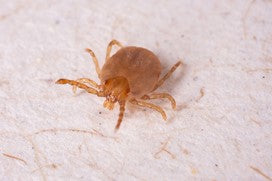
What is Anaplasmosis?

Ticks are small parasitic bugs that feed on the blood of humans and animals. A tick’s bite can transmit harmful diseases, and one of the most common tick-borne diseases is anaplasmosis. Here, we breakdown what anaplasmosis is, what it looks like in both humans and pets, plus ways to prevent it and other tick-borne diseases.
What is Anaplasmosis?
Anaplasmosis is a disease that can be transmitted to humans and other animals via tick bites. This disease is spread by black-legged ticks (also known as deer ticks) and western black-legged ticks, meaning it’s usually found along the West Coast and in the upper Midwest and Northeast regions of the United States.
While anaplasmosis can be contracted any time of year, most cases show up during the spring and summer months as the weather warms and people spend more time outdoors.
Anaplasmosis in Humans
Generally, a tick must be on a human for 12 to 48 hours for anaplasmosis to be transmitted. After a bite from an infected tick, it can take one to two weeks for anaplasmosis symptoms to appear. In most cases, humans experience very mild to moderate symptoms. These include fever, chills, headaches, muscle aches, cough, fatigue, nausea and vomiting. For those who are older, immunocompromised or receive delayed treatment, the symptoms can be much more severe. In the late stage, anaplasmosis symptoms can include organ failure, bleeding problems and respiratory failure. There is a less than 1% fatality rate for anaplasmosis.
If you’ve been bitten by a tick and start experiencing any symptoms of anaplasmosis within two weeks, you should see a medical professional. A healthcare professional will need to do blood tests to diagnose anaplasmosis, and if they suspect you have it, they may order antibiotics while you await test results. The antibiotic doxycycline is the recommended treatment for both adults and children, and it can prevent serious illness and death.

Anaplasmosis in Pets
Humans aren’t the only ones who can contract anaplasmosis. Our dogs and cats can get it, too. Feline and canine cases of anaplasmosis are found in the same areas as human cases, and the common months for it are May, June and July. For the disease to transmit to pets, the tick must be attached for at least 24 hours, and symptoms can last for one to seven days.
Symptoms in dogs and cats include lethargy, fever, lameness, joint pain and loss of appetite. A vet will need to run a blood test or urinalysis to diagnose your pet with anaplasmosis. Pets are also given the antibiotic doxycycline as treatment.
Preventing Anaplasmosis
Unfortunately, a vaccine for anaplasmosis does not exist, which means the only way to prevent anaplasmosis is by preventing tick bites in the first place or finding ticks before they can transmit the disease. Ticks thrive in grassy or wooded areas, so if you live somewhere ticks are common, take precautionary measures. Use bug repellant and limit the amount of exposed skin when spending time outdoors, especially while camping or hiking. Be sure to check yourself, others and your pets for ticks after walking in grass or wooded areas.
Many people can find ticks right in their own yards. If you find ticks anywhere around your house, bring in professionals to help get rid of them. At MosquitoNix®, we offer a residential pest control service that covers ticks. A licensed professional will come to your home, complete a thorough assessment and come up with the right plan to meet your needs. To get started, request a quote.
Leave a comment
Comments will be approved before showing up.





